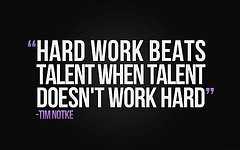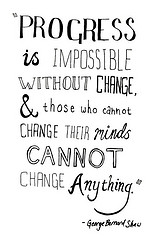|
|
|
Archive for January, 2014
Friday, January 17th, 2014
A Friday series exploring Startups and the people who make them go. Read all If the Shoe Fits posts here
What do you get when you cross an engineer, a craftsman and an artist?
A timeless, utilitarian piece of art that consistently rises in value and can’t be duplicated with technology.
YouTube credit: Metropolitan Museum of Art
Posted in If the Shoe Fits, Innovation | No Comments »
Thursday, January 16th, 2014
 Startup people are notorious for their long work hours. Startup people are notorious for their long work hours.
They’re also known to play hard and not just in bars; most are into some form of working out or athletics and many are into extreme sports.
And most are knowledgeable enough to eat right and allow their bodies to recuperate.
But what about brains?
Brains work just as hard as bodies, if not harder and longer per 24 hour period.
It turns out that brains have their own janitorial system comparable to the body’s lymphatic system that cleans up metabolic toxins.
Maiken Nedergaard, a Danish biologist who has been leading research into sleep function at the University of Rochester’s medical school calls She called it the glymphatic system, a nod to its dependence on glial cells (the supportive cells in the brain that work largely to maintain homeostasis and protect neurons) and its function as a sort of parallel lymphatic system.
The bad news, from the viewpoint of most startup folks, is that it only works while sleeping.
“In a series of new studies on mice, her team discovered exactly that: When the mouse brain is sleeping or under anesthesia, it’s busy cleaning out the waste that accumulated while it was awake.”
But the truly bad news, the news that should make you think twice about ignoring these findings and charging ahead, is the long-term damage.
“The Journal of Neuroscience, the Veasey lab found that while our brains can recover quite readily from short-term sleep loss, chronic prolonged wakefulness and sleep disruption stresses the brain’s metabolism. The result is the degeneration of key neurons involved in alertness and proper cortical function and a buildup of proteins associated with aging and neural degeneration.”
It’s been proven over and over that a tired brain is neither productive nor innovative and now there’s early proof of potentially serious long-range damage from lack of sleep.
After all, what good does it do to improve physical health if your mind is rotting?
“Nationwide, entrepreneurs tend to eat more healthful foods and exercise more than other workers. But they also have more stress and are less likely to have health insurance.”
Worse, there is a chicken-and-egg connection between less sleep and neurodegenerative diseases like Alzheimer’s and Parkinson’s.
Not absolutely proven, but neither was the football connection between concussions and brain problems that is playing out in the courts today.
Editor’s note: Since the subject came up, what makes more sense to solve the problem of how a startup can offer health insurance than a startup with a founder who really understands?
Scott Gerber, founder of the Young Entrepreneur Council, which provides startup mentorship and resources and conducts research on entrepreneurs’ needs. To address this problem, his organization is introducing StartupInsurance, an online platform of health insurance plans offered by major health insurers, which will be compliant with the Affordable Care Act by 2014 and are tailored for entrepreneurs.
Flickr image credit: Adam Goode
Posted in Entrepreneurs | 1 Comment »
Wednesday, January 15th, 2014

Last month we looked at the economic dichotomy of having a consumer-based economy while simultaneously reducing wages.
Henry Ford understood that paying higher wages was good business.
Ford astonished the world in 1914 by offering a $5 per day wage ($110 today), which more than doubled the rate of most of his workers. (…) The move proved extremely profitable; instead of constant turnover of employees, the best mechanics in Detroit flocked to Ford, bringing their human capital and expertise, raising productivity, and lowering training costs.
Not to mention that a good part of that disposable income was used to buy Ford cars.
Business counters that idea by pointing to all the costs that didn’t exist in 1914 as justification for relentlessly cutting wages and benefits.
But nothing justifies the current minimum wage in many states.
Speaking of a hundred years, it took that long for new research by Zeynep Ton, a business professor at M.I.T.’s Sloan School of Management and author of “The Good Jobs Strategy,” to prove Ford was correct.
For every dollar of increased wages, one retailer that was studied by Fisher brought in $10 more in revenue. For more-understaffed stores in the study, the boost was as high as $28.
Not only doe it affect employees, but apparently higher wages has a halo effect on stock.
Costco pays its workers about $21 an hour; Walmart is just about $13. Yet Costco’s stock performance has thoroughly walloped Walmart’s for a decade.
Ton’s work is of major competitive importance whether you’re a boss in a small business or head up a giant enterprise.
Flickr image credit: ping.fm
Posted in Compensation, Motivation | 1 Comment »
Tuesday, January 14th, 2014

Twice a week Adam Bryant interviews CEOs from a myriad of companies, large and small, across the industry spectrum, for his Corner Office feature in The New York Times.
As with anyone who spends time talking with CEOs about staying competitive the constant theme he’s found boils down to one word—culture.
Now Bryant has distilled the knowledge and insights gathered from hundreds of interviews into a new book, “Quick and Nimble: Lessons From Leading C.E.O.’s on How to Create a Culture of Innovation”
The six key tenets identified should come as no surprise,
- A Simple Plan
- Rules of the Road (corporate values)
- A Little Respect (embedded in the culture)
- It’s About the Team (performance and accountability, trustworthiness and dependability)
- Adult Conversations (frank discussions to work through disagreements and misunderstandings)
- The Hazards of Email (ease of misunderstanding)
Not new and certainly not rocket science, but worth reading (at the very least read the article).
Good information to help you improve nimbleness and innovation in your own organization.
And a great gift if you happen to work for bosses who don’t see the point.
Flickr image credit: Joanna Lee Osborn
Posted in Culture, Ducks In A Row, Innovation | No Comments »
Monday, January 13th, 2014
 A feedback loop is the combination of process and culture that keeps a boss aware of what’s going on in the organization, no matter the level, scope or size. A feedback loop is the combination of process and culture that keeps a boss aware of what’s going on in the organization, no matter the level, scope or size.
I recently sent KG Charles-Harris a link to an article and a question, “Do you think that experts like Craig Pirrong and Scott Irwin actually believe they really aren’t influenced by the funding they receive from the same groups they are supposed to objectively critique?”
Pirrong and Scott are academics and their funding is from Wall Street, but the situation is similar to the doctors who receive funding from the pharmacies whose drugs they extol in independent symposiums or the researchers who vindicate the food companies that pay for their studies and their labs.
KG replied with a quote from Upton Sinclair, “It is difficult to get a man to understand something, when his salary depends on his not understanding it.”
Succinct, accurate and something for all bosses to stay aware of when creating their group’s feedback loop.
Flickr image credit: Stan and Miran
Posted in Communication, Culture | No Comments »
Friday, January 10th, 2014
A Friday series exploring Startups and the people who make them go. Read all If the Shoe Fits posts here
 Last week two companies were in the news. Last week two companies were in the news.
One successfully gamed the gods of Google, as millions of others have tried to do for years, got caught and was banished from the kingdom.
The other’s security was breached and more than four million of its customers’ phone numbers were published.
The one that did no damage to its customers apologized.
The one that betrayed its users did nothing—no apology, no explanation and no security fix.
Even granting the incredible level of today’s tech arrogance saying/doing nothing is a little much.
My question to you is simple; in similar circumstances who would you follow, the founders of Rap Genius or Snapchat CEO Evan Spiegel?
Image credit: HikingArtist
Posted in Entrepreneurs, Ethics, If the Shoe Fits | No Comments »
Thursday, January 9th, 2014
Have you noticed that many of the hot startups from young founders are relatively shallow—focused on sharing pictures and facilitating casual hookups.
Facebook was originally a way for college students to connect with each other campus by campus and Twitter was more a digital gossip line than a vehicle for the likes of Arab Spring.
There’s a simple reason for that—people tend to create solutions for the problems they find in their own lives.
It’s not so much how old you are but your experiences and how you see the world that makes for great entrepreneurs—but more are older than younger.
“The average age of a successful entrepreneur in high-growth industries such as computers, health care, and aerospace is 40. Twice as many successful entrepreneurs are over 50 as under 25. The vast majority — 75 percent — have more than six years of industry experience and half have more than 10 years when they create their startup,” says Duke University scholar Vivek Wadhwa, who studied 549 successful technology ventures. Meanwhile, data from the Kauffman Foundation indicates the highest rate of entrepreneurship in America has shifted to the 55-64 age group, with people over 55 almost twice as likely to found successful companies than those between 20 and 34.
These are the people who often tackle enterprise and healthcare challenges, because they have been stymied with them in their own work.
Additionally, the larger the worldview the greater the level of empathy leading to substantially more compassion and a stronger desire to “fix it.”
A good example of this is found in Project Daniel.
Project Daniel started in 2012, when Mick Ebeling read a story in Time magazine about Daniel Omar, a then 14-year-old Sudanese boy who lost both his hands from a bomb. It inspired Ebeling to assemble a team capable of creating a low-cost, 3D-printed prosthetic on consumer-grade 3D printers.
Ebeling is the founder of Not Impossible, a company dedicated to “technology for the sake of humanity” which also developed the Eyewriter.
Now you, too, can volunteer with a team, expand your worldview and help change lives, as well as expand your network and have great bragging rights.
YouTube credit: Not Impossible Labs
Posted in Entrepreneurs | No Comments »
Wednesday, January 8th, 2014
 Do you really need to hire stars? Do you really need to hire stars?
Can a manager build a winning team with other teams’ castoffs?
Before you say no take a look at the Phoenix Suns.
“By making feature artists out of other teams’ backups, Ryan McDonough, the Suns’ first-year general manager, has created a group that performs in perfect harmony.”
He also avoids all the ego and drama that comes with hiring so-called stars.
McDonough understands that before anyone can perform they need the opportunity to do so.
“Just because somebody hasn’t done something doesn’t mean they can’t do it. It might just mean they need an opportunity.”
If you listen to the media and a plethora of managers you will hear abut a talent shortage.
They will moan that amidst the enormous number of job-seekers there is not one shred of the talent that they need.
Managers forget that that “proven talent” happened under a specific set of circumstances in a specific culture and with a specific management style—change one or more of those and there is no guarantee of the same performance.
They also forget building a winning team is a key ingredient of the job for which they were hired and are paid the big bucks.
They also will never have the pleasure and personal ego trip of hearing a team member say something like this.
“I kind of always knew I had this in me,” Miles Plumlee said, “but I never guessed I’d be where I’m at already.”
Flickr image credit: Arya Ziai
Posted in Culture, Hiring, Motivation | No Comments »
Tuesday, January 7th, 2014
 Company culture has been jerked around ever since a few pundits decided that “fun” was the primary component to having happy employees. Company culture has been jerked around ever since a few pundits decided that “fun” was the primary component to having happy employees.
Worse, “fun” was equated with silly stuff, such as games, pranks and goofs.
While these things do energize some employees, they don’t do it for long and certainly not alone.
It’s well-proven that happy employees are more productive, but creating happy requires substance.
The components of long-term happiness are things such as challenging work, continued learning, opportunities to grow, clear communications, fair bosses, etc.
All of these require more thought, effort and skill from managers than installing a few foosball tables or gamifying the project.
Flickr image credit: CityLineSouvenir
Posted in Culture, Ducks In A Row | No Comments »
Monday, January 6th, 2014

There was a time, and still is to millions, when “design” meant looking pretty—or not.
Design certainly didn’t refer to finding solutions to life’s real problems.
Of course, first you have to identify the problems, which isn’t done 140 characters at a time.
You won’t find them with Google and there’s no app for that.
Identifying real-world problems requires actually talking (gasp) to people—and real world experience doesn’t hurt.
This may be why senior entrepreneurs are on the rise, since it means communicating with empathy and putting yourself in someone else’s shoes.
Empathy seems to be in short supply the younger you go, but it can be taught and where else but at D.school—the top design school.
At the heart of the school’s courses is developing what David Kelley, one of the school’s founders, calls an empathy muscle. … the students are taught to forgo computer screens and spreadsheets and focus on people.
So far, that process has worked. In the eight years since the design school opened, students have churned out dozens of innovative products and start-ups. They have developed original ways to tackle infant mortality, unreliable electricity and malnutrition in the third world, as well as clubfoot, a common congenital deformity that twists a baby’s feet inward and down. (…)
Mr. Kothari also said his plans took a new path. Before he took his first D.school course in 2008, he said, he spent most of his spare time in front of a computer, brainstorming ideas for websites and mobile apps that never materialized. Design was always an afterthought. But he says that first ramen assignment became the prelude to a revolutionary new way of solving problems by spending time with people to understand how they live their lives.
Empathy muscle.
I like that.
Too bad the teaching is limited to design and only at one school.
It’s definitely a muscle that is lacking in many of the under-25 crowd and badly atrophied in much of the rest of the population.
Flickr image credit: Arya Ziai
Posted in Personal Growth | No Comments »
|
 Subscribe to
Subscribe to
MAPping Company Success
About Miki 
Clarify your exec summary, website, etc.
Have a quick question or just want to chat? Feel free to write or call me at 360.335.8054
The 12 Ingredients of a Fillable Req
CheatSheet for InterviewERS
CheatSheet for InterviewEEs™
Give your mind a rest. Here are 4 quick ways to get rid of kinks, break a logjam or juice your creativity!
Creative mousing
Bubblewrap!
Animal innovation
Brain teaser
The latest disaster is here at home; donate to the East Coast recovery efforts now!
Text REDCROSS to 90999 to make a $10 donation or call 00.733.2767. $10 really really does make a difference and you'll never miss it.
And always donate what you can whenever you can
The following accept cash and in-kind donations: Doctors Without Borders, UNICEF, Red Cross, World Food Program, Save the Children
*/
?>About Miki
About KG
Clarify your exec summary, website, marketing collateral, etc.
Have a question or just want to chat @ no cost? Feel free to write
Download useful assistance now.
Entrepreneurs face difficulties that are hard for most people to imagine, let alone understand. You can find anonymous help and connections that do understand at 7 cups of tea.
Crises never end.
$10 really does make a difference and you’ll never miss it,
while $10 a month has exponential power.
Always donate what you can whenever you can.
The following accept cash and in-kind donations:
|




 Startup people are notorious for their long work hours.
Startup people are notorious for their long work hours.

 A feedback loop is the combination of process and culture that keeps a boss aware of what’s going on in the organization, no matter the level, scope or size.
A feedback loop is the combination of process and culture that keeps a boss aware of what’s going on in the organization, no matter the level, scope or size. Last week
Last week 
 Company culture has been jerked around ever since a few pundits decided that “fun” was the primary component to having happy employees.
Company culture has been jerked around ever since a few pundits decided that “fun” was the primary component to having happy employees.

